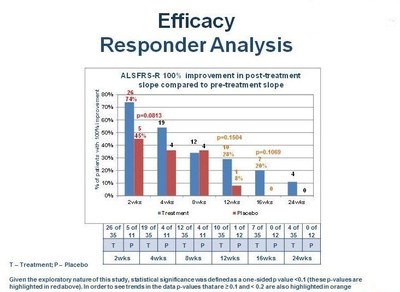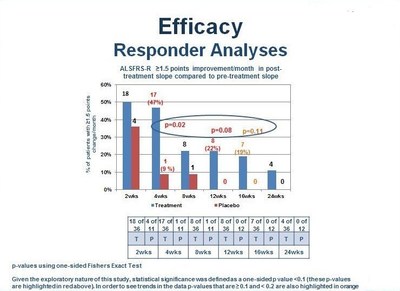News
Press Releases
HACKENSACK, N.J. and PETACH TIKVAH, Israel, July 18, 2016 /PRNewswire/ -- BrainStorm Cell Therapeutics Inc. (NASDAQ: BCLI), a leading developer of adult stem cell therapeutics for neurodegenerative diseases, today announced results from the recently completed U.S. randomized, double-blind, placebo-controlled phase 2 Study of NurOwn® in Patients with ALS. The study achieved its primary objective, demonstrating that NurOwn was safe and well tolerated. NurOwn also achieved multiple secondary efficacy endpoints, showing clear evidence of a clinically meaningful benefit. Notably, response rates were higher for NurOwn-treated subjects compared to placebo at all time points in the study out to 24 weeks.

"We are very encouraged by these Phase 2 data that show that NurOwn cell therapy is safe and that a single administration produces a transient and clinically meaningful beneficial response in terms of both the ALS-FRS-R rating scale and CSF biomarkers," said Dr. Robert H. Brown, Professor and Chair of Neurology at the University of Massachusetts Medical Center and Medical School, and investigator in the trial. "These exciting findings clearly indicate that it is appropriate to conduct a longer study with repetitive dosing."
"We are excited about the trial results which provide important information on safety, preliminary efficacy and biological effects of NurOwn," said Merit E. Cudkowicz, MD, MSc, Professor of Neurology at Harvard Medical School and Chief of Neurology at Massachusetts General Hospital. "More participants in the treated group had slowing of progression and there were no safety concerns. The increased levels of growth factors in the cerebrospinal fluid and decreased inflammatory markers observed after two weeks are encouraging evidence for a biological effect. Based on these results, repeat dosing at 8 to 12 weeks and a larger confirmatory trial are warranted. I look forward to continuing to work closely with Brainstorm on the development of NurOwn for ALS."
"After almost thirty years of conducting clinical studies in ALS I am personally very encouraged and excited by the trial results." stated Anthony J. Windebank M.D, Professor of Neurology and Director for Discovery, Mayo Clinic Center for Regenerative Medicine. "There are positive efficacy signals with clear indications to proceed to the next phase. We at Mayo clinic will be eager to move ahead with that as soon as possible."
"Patients in the Brainstorm study tolerated treatment extremely well and there were no serious adverse events related to therapy. The safety profile certainly provides the opportunity to continue to study this approach to ALS treatment." stated Carlayne E. Jackson, MD, FAAN, Professor of Neurology and Otolaryngology, Chief Medical Officer - UT Medicine San Antonio, University of Texas Health Science Center who served as the chair of the Data Safety Monitoring Board on this study.
"I would like to thank the patients who participated in this clinical trial as well as the investigators, DSMB members and all those who contributed to the successful completion of this trial. These data give us valuable insights into the beneficial treatment effect with NurOwn" stated Chaim Lebovits, CEO of BrainStorm. "This study met its objectives, demonstrating both the safety of NurOwn and its ability to provide clinical benefit to ALS patients, and most importantly, will help us to determine the study population and design for a pivotal study of multiple doses of NurOwn in ALS."
Study Design
The Phase 2 trial was a randomized, double-blind, placebo-controlled multi-center study designed to evaluate the safety and efficacy of NurOwn in 48 ALS patients. It was conducted at three sites in the U.S: Massachusetts General Hospital, UMass Medical School and the Mayo Clinic. Patients were randomized to receive NurOwn cells administered via combined intramuscular and intrathecal injection (n= 36), or placebo (n=12). They were followed monthly for approximately three months before treatment and six months following treatment, assessed at 2, 4, 8, 12, 16 and 24 weeks. The primary objective of the study was safety and tolerability. The pre-specified efficacy analyses were: change in the slope of Amyotrophic Lateral Sclerosis Functional Rating Scale (ALSFRS-R) score, change in Slow Vital Capacity (SVC) and muscle strength, responder analysis (the percentage of subjects who improved post-treatment compared with pre-treatment), and a subgroup analysis excluding slowly progressing patients who are less likely to have a detectable benefit from NurOwn. Given the exploratory nature of this study, statistical significance was defined as a one-sided p value <0.1 using Fisher's exact test.
ALSFRS-R Responder Analysis, Intent-to-Treat Population
The pre-specified responder analysis examines both percentage improvements and absolute point improvement per month in post treatment ALSFRS-R slope compared to pre-treatment slope. The first of these looked at patients who achieved 25%, 50%, 75% and 100%improvement. Neurologists view a 25% improvement in slope as at least somewhat clinically meaningful, and a 50% improvement in slope as very clinically meaningful (Castrillo-Viguera et al, Amyotrophic Lateral Sclerosis 2010; 11: 178_180)2.
Across all definitions of "responder" and at all except one timepoint studied, a higher percentage of NurOwn-treated subjects were responders compared to placebo. As an example, at week 12 (post-treatment), 40% of subjects in the NurOwn arm, versus just 17% of placebo subjects, experienced an improvement in the ALSFRS-R slope post-treatment compared to pre-treatment of at least 50%.
The chart below shows the benefit seen in NurOwn treated patients; responders were defined using a very high threshold of 100% improvement in the slope post-treatment compared to the pre-treatment slope, meaning a subject needed to have stable disease or improve to be defined as a responder. The chart below demonstrates both the near-term and long-term benefit of NurOwn treated subjects as compared to placebo.

When response to treatment was evaluated based on the absolute point improvement/month in ALSFRS-R post treatment slope compared to pre-treatment slope over time, again there was strong evidence of a NurOwn treatment effect. The chart below shows the results for patients who achieved a 1.5 or greater point improvement per month in the ALSFRS-R slope out to 24 weeks, demonstrating a benefit in favor of NurOwn at each time point and that was statistically significant at 4, 12 and 16 weeks.

ALSFRS-R Responder Analyses, Faster-Progressing Subgroup
Given that NurOwn is thought to slow disease progression, a pre-specified subgroup was defined in order to exclude subjects whose disease was progressing slowly (defined by an ALSFRS-R slope of -0.7 or higher during the pre-treatment phase). These subjects would be less likely to have a detectable benefit from NurOwn. The more rapidly progressing subgroup, comprising approximately half of the subjects in the study, showed a marked benefit from NurOwn treatment: 94% of those treated with NurOwn (n=18) achieved 100% improvement in slope at 2 weeks, compared to only 20% in the placebo (n=5) group (p = 0.0027)(1). At 4, 8, 12, 16 and 24 weeks the proportion of responders in the active treatment group compared to placebo were 78% vs. 20%, 44% vs. 20%, 39% vs. 17%, 33% vs. 0% and 22% vs. 0%. The figure below displays these results.

Biomarker Analysis
Cerebral-spinal fluid (CSF) samples were collected from patients, as specified in a protocol amendment, after the first 8 patients had already been treated. A total of 35 samples from pre- and post-transplantation visits were available for analysis. Levels of neurotrophic factors and inflammatory factors in each sample were measured. A statistically significant increase in levels of VEGF and HGF from pre- to post-transplantation was observed in the samples of those patients who responded to NurOwn. There was also a statistically significant reduction in inflammatory markers (MCP-1 and SDF-1) over this period, in patients treated with NurOwn that was not observed in the placebo group.
Safety
NurOwn was found to be safe and well tolerated with the majority of adverse events being mild or moderate.
There were no deaths reported in the study and no patients discontinued participation because of an adverse event. All patients in both active treatment and placebo groups experienced at least one treatment-emergent adverse event. Adverse events tended to be mild-to-moderate in intensity in both groups. Treatment-related adverse events, as determined by the blinded investigator, occurred slightly more frequently in active-treated patients than in placebo-treated patients, 97.2% vs. 75.0%. The largest differences in frequencies were for the localized reactions of injection site pain and back pain, and systemic reactions of pyrexia, headache, and arthralgia. The pattern of adverse events is consistent with a transient reaction to the transplantation. These adverse events were minor in nature and self-limiting. Post-therapy serious adverse events (SAEs) tended to occur more frequently in active-treatment patients (8/36, 22.2%) than in placebo patients (1/12, 8.3%). Most SAEs were related to progression of the underlying ALS, most commonly dysphagia. No SAEs were related to study treatment. The risk-benefit ratio for MSC-NTF cells remains positive.
(1) All efficacy analyses used a 1-sided alpha=0.10 test
(2) Clinical significance in the change of decline in ALSFRS-R, Amyotrophic Lateral Sclerosis. 2010; 11: 178_180. The validity of using a "responder analysis" and the level for which endpoint scores would be considered clinically meaningful in ALS patients was explored in a survey of 65 clinicians published in Amyotrophic Lateral Sclerosis in 2010. "All participants in this survey endorsed a 25% or higher change in the ALSFRS-R score as being at least somewhat clinically meaningful. Ninety three percent of participants viewed a 50% change in decline as being very clinically meaningful".
Conference Call Details:
Monday, July 18, 2016 @ 10:00am Eastern Time
US Toll Free: 888-452-4023
Israel Toll Free: 1 80 924 5906
International: 719-457-1512
Conference ID: 5455376
Webcast: http://public.viavid.com/index.php?id=120422
Replays, available through August 1, 2016
Toll Free: 877-870-5176
International: 858-384-5517
Conference ID: 5455376
About BrainStorm Cell Therapeutics Inc .
BrainStorm Cell Therapeutics Inc. is a biotechnology company engaged in the development of first-of-its-kind adult stem cell therapies derived from autologous bone marrow cells for the treatment of neurodegenerative diseases. The Company holds the rights to develop and commercialize its NurOwn technology through an exclusive, worldwide licensing agreement with Ramot, the technology transfer company of Tel Aviv University. NurOwn has been administered to over 30 patients with ALS in clinical trials conducted in Israel, and is currently being studied in a randomized, double-blind, placebo-controlled clinical trial in the United States. For more information, visit the company's website at www.brainstorm-cell.com.
Safe Harbor Statement
Statements in this announcement other than historical data and information constitute "forward-looking statements" and involve risks and uncertainties that could cause BrainStorm Cell Therapeutics Inc.'s actual results to differ materially from those stated or implied by such forward-looking statements. Terms and phrases such as "may", "should", "would", "could", "will", "expect", "likely", "believe", "plan", "estimate", "predict", "potential", and similar terms and phrases are intended to identify these forward-looking statements. The potential risks and uncertainties include, without limitation, risks associated with BrainStorm's limited operating history, history of losses; minimal working capital, dependence on its license to Ramot's technology; ability to adequately protect the technology; dependence on key executives and on its scientific consultants; ability to obtain required regulatory approvals; and other factors detailed in BrainStorm's annual report on Form 10-K and quarterly reports on Form 10-Q available at http://www.sec.gov. These factors should be considered carefully, and readers should not place undue reliance on BrainStorm's forward-looking statements. The forward-looking statements contained in this press release are based on the beliefs, expectations and opinions of management as of the date of this press release. We do not assume any obligation to update forward-looking statements to reflect actual results or assumptions if circumstances or management's beliefs, expectations or opinions should change, unless otherwise required by law. Although we believe that the expectations reflected in the forward-looking statements are reasonable, we cannot guarantee future results, levels of activity, performance or achievements.
Contacts
Media:
Stu Loeser & Co.
stu@stuloeser.com
212-858-9400 x101
Company:
Uri Yablonka
Chief Operating Officer
Brainstorm Cell Therapeutics Inc.
Phone: 646-666-3188
uri@brainstorm-cell.com
Investors:
Michael Rice
LifeSci Advisors, LLC
Phone: 646-597-6979
mrice@lifesciadvisors.com
Photo - http://photos.prnewswire.com/prnh/20160718/390384
Photo - http://photos.prnewswire.com/prnh/20160718/390385
Photo - http://photos.prnewswire.com/prnh/20160718/390386
Logo - http://photos.prnewswire.com/prnh/20141006/150511
To view the original version on PR Newswire, visit:http://www.prnewswire.com/news-releases/brainstorm-announces-positive-top-line-results-from-the-us-phase-2-study-of-nurown-in-patients-with-amyotrophic-lateral-sclerosis-als-300299813.html
SOURCE BrainStorm Cell Therapeutics Inc.
Tools
Investors
- Overview
- News
- Events & Presentations
- Stock Information
- Financial Reports & Filings
- Corporate Governance




